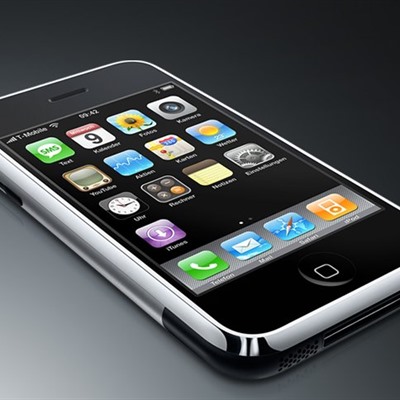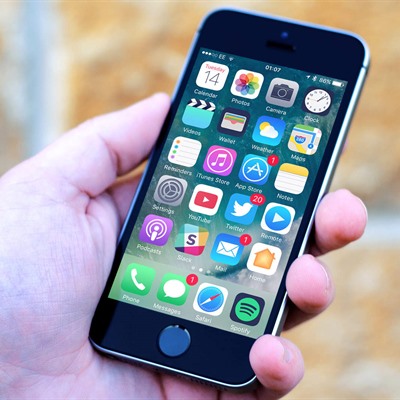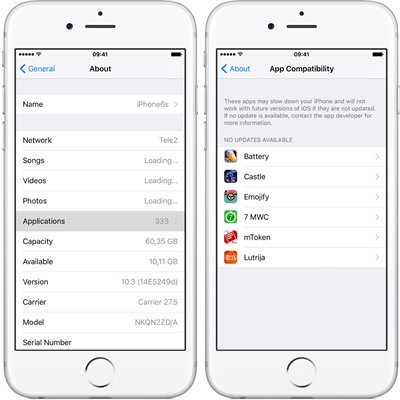
A bit of history
Apple launched its operating system – then called iPhone OS – on 29 June 2007, with the first iPhone. Steve Jobs introduced a new mobile phone with a new OS referring to it as OS X as it shared a similar Unix core compared to a desktop version of the system. One year later, after the release of iPhone Software Development Kit, the name was changed into iPhone OS.

The very first iPhone turned out to be one of the most important and influential gadgets of all time. It defined the look of the smartphone display with a grid of apps on a screen which hasn’t changed much throughout the years. A brilliant idea of packing an iPod, camera, phone and Internet browsing into one pocket-size device marked the beginning of immense popularity and recognisability which, with various ups and downs, is still enjoyed by one of the Cupertino giant’s flagship products.
Developing new versions
Each consecutive version of iOS added new features to the system making it more and more fit for mobile computing. Its second version allowed for adding third-part apps (with what is now known as the App Store). Prior to that, iPhone was basically a walking ad for Apple and its products. Its second release made the OS infinitely more useful.
The next version added push notifications, tethering, MMS support and Spotlight search tool. With the 4th release of the system (now officially known as iOS after the “Phone” part was dropped, Apple began to define a new communication frontier with FaceTime thus making a so-far futuristic concept of real-time video phone a reality.
Following versions added such features as Notification Center, iMessage and Siri – another Sci-Fi idea of a digital assistant which went far beyond a simple voice-control being able to do actions on your behalf and even tell jokes. After the divorce with Google, Apple created its own mapping service. iOS 7 was redesigned with a simpler design, flatter icons, quick access Control Center, AirDrop and Touch ID.
The most recent versions of iOS brought such solutions as NFC-enabled Apple Pay, Apple Music, 3D Touch and opened the software development kit to developers with Siri, Maps and iMessages giving an incredible potential to those apps to be developed way beyond their initial possibilities by integrating them with third-party applications.
A major overhaul
The next generation of the system, iOS 11, was introduced on 5 June, 2017 at the Worldwide Developers Conference. Apart from subtle design changes such as redesign of the Lock screen and Control Center as well as minor things like bolder text and a new look of some apps, iOS 11 brings a couple of quite revolutionary changes.
One of them is the Files App – a completely new approach to file management on iPhone which is designed to mimic the Finder app on the Mac. Just like the Finder for Mac, it’s searchable, has a section for viewing all recently accessed files, and it supports tags, spring-loading, nested folders, and favorites. Files also houses all of the content stored locally on the iPhone or iPad, iCloud content, app content, and content stored in other cloud services like Dropbox, Box, One Drive, Google Drive, and more.
Another feature, which will be immensely useful is a Drag and Drop feature. It will allow you to drag content like images, text or links from one app to another. It will also be helpful with the new Files app by quick and efficient drag-and-drop files management. A new iOS version will also host a new and more intelligent Siri assistant with its much deeper integration with such apps like Apple News, Safari, Apple Music or Calendar. Siri will also be able to translate English to Chinese, French, German, Italian, and Spanish with more languages planned to be added over the coming months. NFC-based peer-to-peer Apple Pay will also make it easier to manage payments among Apple gadgets users.
There will be plenty of new features for iPad users including all functionalities described above plus a lot of goodies such as Mac-inspired iPad Dock and App Switcher, QuickType Keyboard and Apple Pencil. Many apps will be revamped (e.g. new Notes with handwriting recognition, Maps with indoor maps of selected malls and airports as well as lane assist, Camera with Live Photos, AirPlay 2 with multi-room and FLAC lossless audio support and many others) and new ones will be added (e.g. Do Not Disturbed While Driving, Automatic Setup or QuickType one-handed keyboard).
From A7 chip up
Much as the new OS is loaded with new or upgraded useful features and is obviously one of the most hotly anticipated Apple releases of the year, it also constitutes certain drawbacks. One of them includes the fact that it will support devices that have an A7 chip or better (iPhones from the 5s model up), which means that iPhone 5 users (and all those with earlier versions of the phone) will not be able to benefit from the update.
Apps compatibility issue

One of the major drawbacks of the new update is the fact that iOS 11 will only support newer 64-bit apps. Currently available versions of iOS support both older 32-bit apps and newer 64-bit apps. Those apps which are maintained by developers and updated regularly will not be affected but App Store includes thousands of older apps that have not been updated to 64-bit. What it means is that some of the apps that you have been using every day may effectively stop working once you install a new iOS update.
How do I know which apps will stop working?
It seems a hectic job to check which apps are 32 and which are 64-bit especially if you happen to be a fan of installing various apps on your device. If you are running iOS 10 or later, however, it is extremely easy to find out which applications may become useless with the advent of iOS 11. It can be done if four simple steps:
-
Open the Settings app
-
Tap General
-
Tap About
-
Tap Applications


The last screen will show you exactly which apps on your device are 32-bit apps and, unless they are updated, they will stop working with future versions of the iOS. The screen suggests that you should contact the app developer for more information but, unfortunately, there’s not much an average user can do about it.
Most of widely popular and used apps are updated to 46-bit. You probably don’t need to worry that you will suddenly lose your Face Book or Twitter feed. However, strangely enough, there are a few popular apps (at least for now) that are still 32-bit. One of them is Google Earth. Let us just hope that developers of the most often installed apps from App Store will run 64-bit updates before the users switch to a new version of iOS.
BACK TO NEWS